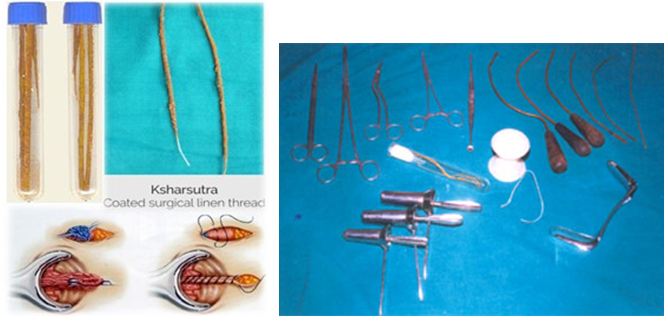KSHARSUTRA TREATMENT

WHAT IS KSHARSUTRA ?
The Ksharsootra /Ksharsutra is a type of thread / medicated setone prepared by coating and recoating the thread 15 to 21 times with different drugs of plant origin. The mechanical action of the treads and the chemical action of the drugs coated on the thread, to gather do the work of cutting, curetting, draining, and cleaning the fistulous track, thus promoting healing of the track/ wound. A number of drugs like:
- Apamarg kshar
- Kadali kshar
- Arka kshar
- Nimb kshar
- Snuhi ksheer
- Udumber ksheer
- Papaiya ksheer
And natural antibiotic like haridra powder, guggulu, etc are used in the preparation of different kind of Ksharsutra. It takes a number of days to prepare this Ksharsutra since the previous coat has to dry before the next is applied. Different kinds of Ksharsootra are prepared using different drugs. These Ksharsutra are passed through the track (usually under short anesthesia) and the two ends of the thread are tied forming a loop. The changing of the thread is a simple opd procedure taking about 1 to 2 minutes and requires no anesthesia. the thread gradually cuts through the tissue. The tissues above the thread heal up. Hence when at last the loop of thread comes out, the track is healed.
KSHARSOOTRA
(medicated setone) therapy is practiced in India since times immemorial. Modified and revived by the late Dr. P. J. Deshpande. The Ksharsootra therapy is a unique treatment of Ayurveda gaining popularity globally. Special types of medicated setone are used in this procedure Found to be effective in any ano rectal conditions, it has many advantages in the treatment of Anal fistulae.
BENEFITS OF THE KSHARSUTRA LIGATION PROCEDURE OVER OTHER METHODS
The Ksharsootra ligation method is an age old, time tested procedure originally performed by Sushruta (the father of surgery) around 300 ad. The fact that it is still in practice to day is a proof in it self of its efficacy.
HOW CAN I TAKE CARE OF MYSELF ?
- Using stool softeners
- Adding fiber to your diet
- Drinking plenty of water, up to 8 eight-ounce glasses a day
- Taking warm baths
- Using clean, moist pads to wipe the area around the anus, to remove irritating particles and fluid from the fistula.
- Using special skin creams to soothe irritated tissue.
How can i help prevent an anal fistula?
Follow these guidelines to help prevent an anal fistula. They help to keep the lower gastrointestinal tract healthy. Have regular physical exams to look for underlying diseases of the rectum. Be aware of the signs and symptoms of bowel disease, and seek medical attention if any appear.
Make an Appointment